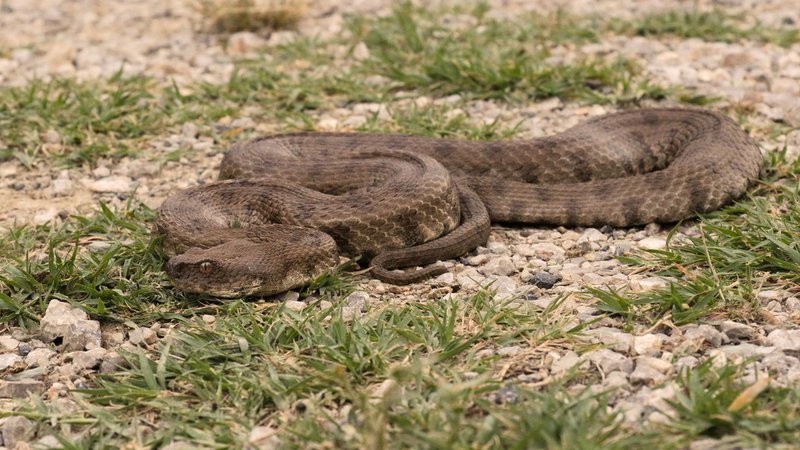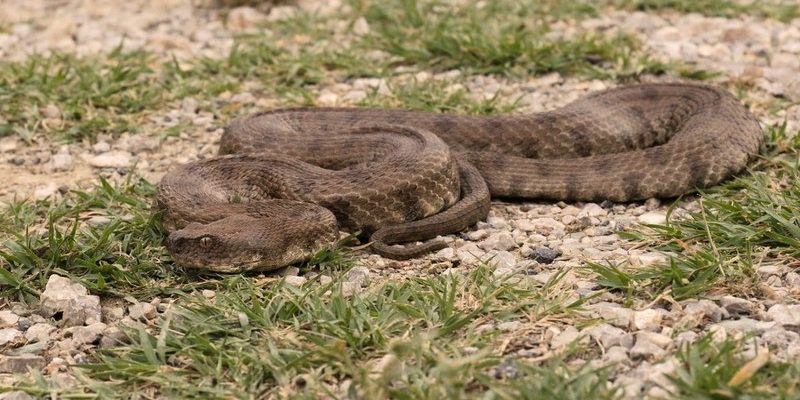
The Blunt-Nosed Viper, a fascinating creature found primarily in parts of Europe and Asia, is a unique member of the viper family. Imagine a snake with a slightly rounded head, blending seamlessly into its rocky habitat. This viper might not win any beauty contests with its drab colors, but its specialized adaptations make it a remarkable survivor in its challenging environment. If you’re curious about what makes this snake tick, you’re in for a treat.
Often considered shy and elusive, the Blunt-Nosed Viper has adapted its lifestyle to thrive in rocky terrains and shrublands. While many snakes rely on vibrant colors to attract mates or ward off predators, the Blunt-Nosed Viper uses its muted shades of browns and grays to camouflage itself. Picture it lying quietly among pebbles, waiting for the perfect moment to strike at its next meal—a small rodent or lizard. Let’s dig a little deeper into what makes this viper so special.
Physical Characteristics
The physical features of the Blunt-Nosed Viper are essential for its survival. Growing up to around 70 to 90 centimeters in length, this viper sports a relatively short and stocky body, which allows it to blend in with its surroundings effectively. Its most distinctive feature is its blunt head, which gives it its name. You might wonder why this shape matters; it helps the snake navigate through the rocky terrains where it resides and makes digging into the ground much easier.
In terms of coloration, the Blunt-Nosed Viper exhibits a palette of muted browns, tans, and grays. This coloration is not just for show; instead, it provides excellent camouflage against the stones and dirt of its habitat. When lying in wait, the snake can remain hidden from both predators and potential prey. Have you ever tried to spot a camouflaged creature in nature? It’s challenging! The viper’s ability to blend seamlessly into its environment highlights its evolutionary success.
Another interesting aspect of its appearance is its eyes. Unlike some brightly colored snakes, the Blunt-Nosed Viper has relatively small, slit-like pupils. This feature allows it to see well in low light conditions, making it a proficient hunter at dawn and dusk. Coupled with its excellent sense of smell, this snake is well-equipped to find food in its rugged landscape.
Habitat and Range
The Blunt-Nosed Viper primarily inhabits rocky hillsides, scrublands, and forest edges across regions such as the Balkan Peninsula and parts of Turkey. It enjoys a landscape that offers plenty of shelter, such as crevices or dense underbrush, where it can find refuge from both predators and harsh weather conditions. If you picture a rugged terrain filled with rocks and sparse foliage, you’ve got the perfect home for this clever snake.
Interestingly, its habitat also influences its behavior and diet. By choosing rocky areas, the Blunt-Nosed Viper can effectively hunt for small mammals and reptiles. It’s quite fascinating to think about how the environment shapes the lives of these creatures, influencing everything from their physical adaptations to their hunting techniques. If it were to live in a different setting, such as a dense forest or grassland, it would likely face different challenges.
You might be curious about temperature preferences, too. Blunt-Nosed Vipers are ectothermic, meaning they rely on external heat sources to regulate their body temperature. They bask on warm rocks during the day, soaking in the sun’s rays before retreating to cooler areas as the day heats up. This behavior helps them maintain their energy levels and stay active for hunting.
Diet and Hunting Strategies
The diet of the Blunt-Nosed Viper primarily consists of small rodents, lizards, and sometimes even insects. Imagine it lurking quietly in the shadows, waiting patiently for a unsuspecting mouse to wander too close. When the moment is right, the viper strikes with impressive speed, injecting its prey with venom. This strategy effectively immobilizes its meal, allowing the snake to eat without any struggle.
It’s important to understand that the venom of the Blunt-Nosed Viper, while deadly to its prey, isn’t considered dangerous to humans unless provoked. Their venom is primarily hemotoxic, meaning it works by breaking down the blood and tissues of the victim. So, while these snakes are powerful hunters, they also play a crucial role in their ecosystem by controlling rodent populations.
The hunting method of this snake is quite fascinating. Blunt-Nosed Vipers often rely on ambushing rather than actively chasing down their prey. They may stay hidden for a long time, with only their heads poking out, looking almost like part of the rocks around them. This stealthy approach is essential not only for hunting but also for avoiding potential threats.
Behavior and Reproduction
Now, let’s dive into the behavior of the Blunt-Nosed Viper. These snakes are generally solitary creatures, which means they prefer to roam alone rather than in groups. This independence is essential for their survival, allowing them to have full control over their hunting territories. If you ever spot one, consider yourself lucky—these snakes can be tricky to find!
During the mating season, which typically occurs in the spring, male Blunt-Nosed Vipers can often be seen competing for the attention of females. Their courtship rituals involve a lot of head movements and body posturing, as they try to impress potential mates. Once a female has mated, she will lay a clutch of eggs, usually in a hidden location to protect them from predators. This careful approach to parenting ensures that the next generation has a better chance of survival.
Interestingly, Blunt-Nosed Vipers can exhibit some social behavior during the mating season. Males sometimes form temporary aggregations, leading to fascinating displays of competition. You might be surprised to learn that, despite being solitary creatures, they can come together when it’s time to reproduce. It’s a reminder of how wildlife can be full of surprises!
Conservation Status
The conservation status of the Blunt-Nosed Viper is a topic of concern. As habitat loss and climate change continue to threaten their natural environments, the populations of these unique reptiles are at risk. Deforestation, urban development, and agricultural expansion are encroaching upon their habitats, leading to decreased numbers. It’s as if the very stones they hide behind are slowly being taken away.
Efforts to conserve Blunt-Nosed Vipers include habitat protection initiatives and awareness campaigns to educate the public about their importance in the ecosystem. These snakes are vital for maintaining the balance of their environments, helping control rodent populations. Imagine the ripple effect if these snakes disappeared—more rodents could lead to crop damage and potential disease spread!
In many regions, local communities are becoming increasingly aware of the need to protect these creatures. Conservation organizations are working hard to create protected areas where Blunt-Nosed Vipers can thrive without the threat of habitat destruction. By preserving these habitats, we also ensure a future for these fascinating creatures.
Interesting Facts
| Scientific Name: | Vipera latastei |
| Length: | 70–90 cm |
| Diet: | Small rodents, lizards |
| Habitat: | Rocky hillsides, scrublands |
| Lifespan: | 10–15 years in the wild |
FAQ
What is the Blunt-Nosed Viper’s primary habitat?
The Blunt-Nosed Viper thrives in rocky hillsides and scrublands. It prefers areas where it can find plenty of shelter, like crevices and dense vegetation. This environment not only provides protection from predators but also offers ample hunting opportunities for small rodents and lizards.
Are Blunt-Nosed Vipers dangerous to humans?
Though the venom of the Blunt-Nosed Viper is potent enough to subdue its prey, it’s generally not considered dangerous to humans. Bites can occur if the snake feels threatened, but such incidents are rare. If bitten, it’s important to seek medical attention to manage any potential effects of the venom.
How do Blunt-Nosed Vipers hunt?
Blunt-Nosed Vipers primarily use an ambush strategy to hunt. They remain hidden, camouflaged against the rocky terrain, until their prey comes within striking range. This method allows them to efficiently capture small mammals and reptiles while conserving energy.
What are the main threats to Blunt-Nosed Vipers?
The primary threats facing Blunt-Nosed Vipers include habitat loss due to deforestation, urban development, and climate change. These pressures diminish their natural habitats and food sources, ultimately impacting their population. Conservation efforts are crucial to combat these challenges and protect their environments.
How long do Blunt-Nosed Vipers live?
In the wild, Blunt-Nosed Vipers typically live for about 10 to 15 years. Their lifespan can be influenced by various factors, including habitat conditions, food availability, and predation. In protected or optimal environments, they may even live longer.
Do Blunt-Nosed Vipers have any natural predators?
Yes, Blunt-Nosed Vipers have a few natural predators, including birds of prey and larger mammals. Young viper hatchlings are particularly vulnerable to various birds and snakes. Their ability to blend into rocky environments helps mitigate these threats, but they are still at risk, especially when they are young.
How do Blunt-Nosed Vipers reproduce?
During the mating season in spring, male Blunt-Nosed Vipers compete for females, often exhibiting courtship displays. After mating, females will lay eggs in hidden locations to protect them from predators. Depending on environmental conditions, the eggs will hatch after several weeks.
Can Blunt-Nosed Vipers be kept as pets?
While some people may be interested in keeping Blunt-Nosed Vipers as pets, it’s essential to remember that they require specialized care and a suitable habitat. Additionally, owning native wildlife is regulated in many areas, so it’s crucial to check local laws before considering one as a pet.
What should I do if I encounter a Blunt-Nosed Viper in the wild?
If you encounter a Blunt-Nosed Viper in the wild, the best course of action is to remain calm and give it space. Do not attempt to touch or provoke the snake, as this can lead to defensive behavior. Instead, observe from a safe distance, allowing the snake to continue on its way. Respecting wildlife is vital for their conservation.
What impact do Blunt-Nosed Vipers have on their ecosystem?
Blunt-Nosed Vipers play a crucial role in their ecosystem by controlling rodent populations. By preying on these small mammals, they help maintain a balance in the food web. This ecological role is important for preventing overpopulation of prey species, which can lead to damage to crops and plants.

